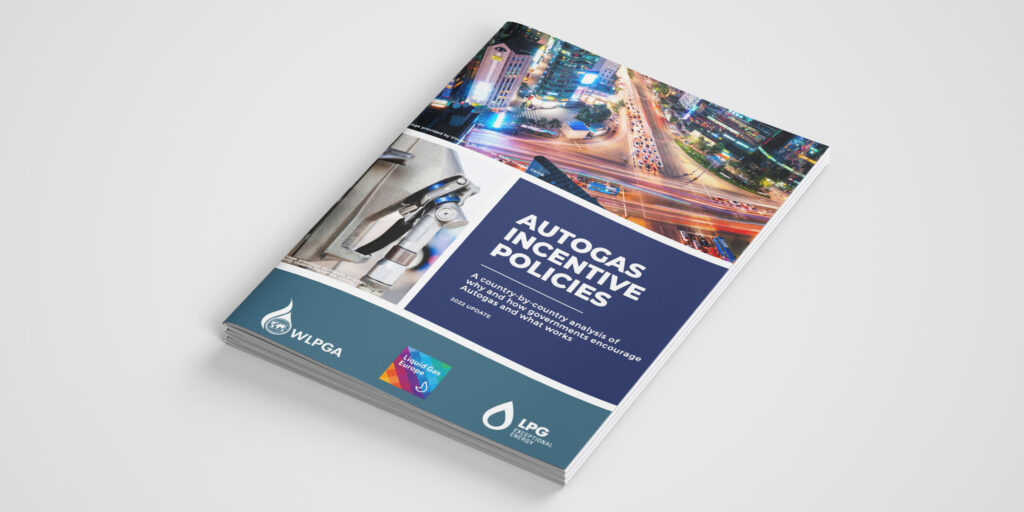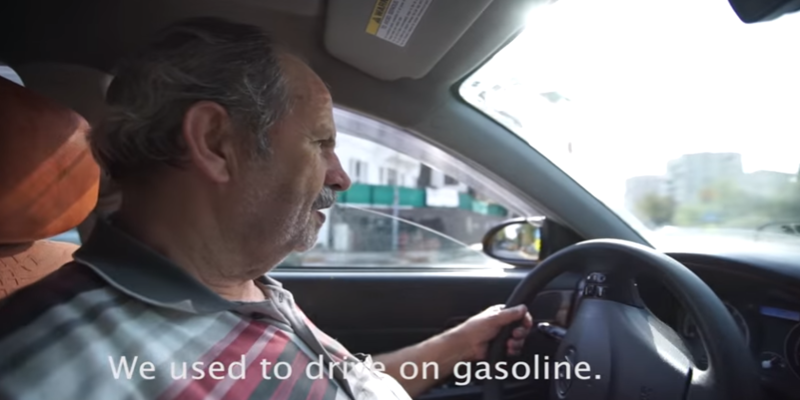LPG in Road
Transportation
LPG, better known as Autogas, LPG as a transport fuel, already plays a key role in reducing emissions and improving air quality. Its unique qualities make it an available and viable alternative to electrification for a part of the vehicle fleet.
What is Autogas?
Liquid Gas, including LPG, is used as a fuel in internal combustion engines in vehicles. It is usually a mixture of propane and butane, but other gases such as DME can be blended in.
In the United States, Autogas is more commonly known under the name of its primary constituent, propane. In the UK, LPG and Autogas are used interchangeably. In Australia, the common terms are LPG and gas. In Italy and France, GPL is used, and in Spain Autogas is referred to as GLP. In many Asian countries the term Autogas is not commonly recognised as a generic term, and the use of the terms LPG or AutoLPG is more common.
Are Autogas and CNG the same fuel?
CNG and Autogas are both gaseous fuels, but they are not the same. CNG is high-pressure compressed natural gas and Autogas is composed of propane or a propane/butane mix.
The pressure in a CNG tank is 200 bar, compared to 7.5 bar for LPG. A car equipped with Autogas cannot be powered by CNG, and vice versa.
What vehicles can run on Autogas?
Eight of the ten largest car manufacturers in the world produce Autogas vehicles. Petrol cars can also be retro-fitted with an Autogas system.
Where is Autogas used?
Globally, the Autogas fleet continues to grow. There are now 28.3 million Autogas vehicles in use around the world and close to 82,000 refuelling stations selling the fuel.
Autogas use is still concentrated in a small number of markets. The five largest – Russia, Turkey, Korea, Poland and Ukraine – together account for almost half of world consumption in 2021, while the top 25 countries account for 80%. The share of Autogas in total automotive fuel consumption varies widely, ranging from a mere 0.04% in the United States to almost 28% in Ukraine. The enormous disparity in the success of Autogas in competing against the conventional automotive fuels of gasoline and diesel is explained mainly by differences in government incentive policies.
The market penetration of autogas is strongly correlated with the competitiveness of Autogas vis-à-vis gasoline and diesel, as well as the availability of models and refuelling infrastructure.
Autogas Goes Renewable
As increased volumes of renewable Liquid Gas become available, renewable Autogas will help further reduce emissions from transport.
Why do governments support Autogas?
Challenges and solutions
Across the world, measures are being taken to reduce emissions from road transport.
DO NOT EDIT
Governments around the world are encouraging the adoption of electric vehicles by offering incentives such as tax rebates, subsidies and access to carpool lanes. The development of charging infrastructure is also a priority to support the widespread adoption of EVs.
Are vehicles produced to run on Autogas without a conversion?
Can any car be converted to LPG Autogas?
Factory fitted or conversion
How safe are Autogas engine systems?
The LPG Autogas systems in today’s modern vehicle are designed to be very safe. They are safe in use, safe to repair and safe in a vehicle accident situation. An Autogas system has a number of important safety features including:
- A welded steel pressure cylinder which is stress-tested to many times its normal operating pressure prior to being installed.
- Two electronically controlled shut-off solenoids (on cylinder and under bonnet) which stop the flow of gas to the engine if the engine stops for any reason.
- Pressure relief valves, for the tank and the system, to prevent any pressure build up that may damage the system or be hazardous.
- Double back-check valves to ensure gas tight filling.
- Sealed compartments and venting around valves and pipe-work to ensure no LPG enters the interior of the vehicle
Is Autogas environmentally friendly?
LPG is one of the most environmentally friendly automotive fuels around, offering a tremendous advantage in towns and cities where pollution is a problem. With an increasing need to protect the world we live in, it’s good news to find that Autogas offers an option to help reduce harmful emissions.
Tests have shown that Autogas emits:
- 10-12% less CO2 than petrol
- 53% less NOx than petrol
- 120 times less small particle emissions than diesel
Is it difficult to fill an autogas-powered vehicle?
Not at all. If you can fill a car with gasoline, you can fill an autogas-powered vehicle. It’s essentially the same process.
Is LPG Autogasdifferent to LPG used for heating or to for my barbecue?
It can be. There are two different grades or blends of LPG and they are not interchangeable. LPG Autogas that is a mixture of Propane and Butane is for automotive use only.
Safety
Autogas is a safe alternative fuel that is non-toxic, non-corrosive and insoluble in water. Fuelling with Autogas is as safe and simple as filling up with gasoline or diesel. Around the world, vehicles of all types, from cars to tuktuks, school buses to police cars, run safely on Autogas.
- Autogas requires a much higher temperature to ignite compared to gasoline and diesel.
- Autogas has the lowest flammability range of any fossil fuel.
- Unlike gasoline and diesel, if Autogas leaks it does not pool or puddle, but instead vaporises and dissipates into the air.
- Since Autogas is released as a vapour, it can’t be ingested like gasoline, diesel or alcohol fuels.
What about my vehicle warranty?
In most countries, your vehicle warranty is not voided by the installation of an LPG system. However, the vehicle manufacturer will not warrant the LPG system (unless fitted or endorsed by them) and the manufacturer may not warrant anything that is affected by having the LPG system fitted or running the vehicle on LPG. These items are covered by the LPG system supplier and installer. Extended warranty products are also available to cover the vehicle for longer periods. Please check with your installer for your warranty options.
What happens if an LPG converted vehicle is involved in an accident?
The LPG tank and fuel pipes are fitted with numerous safety devices. The gas flow will automatically stop if the pipes are damaged or the engine is not running. If the vehicle catches fire, the gas tank pressure is controlled via safely venting excess pressure which will prevent the tank from rupturing and causing further damage. Tanks are made of thick steel.
What is a dual fuel system?
Commonly, Autogas is utilised as part of a dual-fuel system with petrol. Vehicles are fitted with both petrol and LPG tanks. The great benefit of a dual fuel system is that when an Autogas filling station is not available, you can switch your vehicle back to petrol at the click of a button. Having two fuel tanks also allows you to increase the miles covered between filling up.
What is Autogas?
Autogas, or LPG, is a co-product of natural gas and petroleum, occurring naturally during domestic oil refining and natural gas processing. It is 270 times more compact as a liquid than as a gas, making it highly economical to store and transport. When used as an on-road engine fuel, LPG is called autogas.
What is involved in converting a vehicle to run on Autogas LPG?
An LPG conversion results in a bi-fuel car i.e. one that car run either LPG or petrol. A second, independent fuel system is added to the car for which a dedicated fuel tank is needed. The tank is usually fitted in the spare-wheel cavity, but can sometimes be installed underneath the vehicle. As with petrol and diesel, liquid LPG is bought by the litre and pumped into the tank via a hose and a dedicated filling point.
Will converting my car affect its performance?
Converting to Autogas LPG can increase the power and performance of your car especially if it is a turbo model. However, generally there is a small loss in performance, but so small you won’t notice it while driving. What you will notice, compared with a diesel vehicle, is a smoother and quieter ride.
Will converting my car to Autogas affect its performance?
While it is true that Petrol is a slightly more efficient fuel than LPG, any fuel consumption efficiency is more than compensated for by a significant saving on the fuel itself. There is also a slight power loss when LPG replaces petrol in fuel, this difference however is barely noticeable on the road. Driving on LPG will appear smoother and more responsive than when using petrol.
Will LPG Autogas harm my engine?
No. Autogas is a cleaner burning fuel that doesn’t contain acids or leave behind carbon deposits. It can, in fact, increase the life of the engine.
Autogas Day
2024

Held annually during LPG Week, Autogas Day provides a global platform to celebrate the advantages of Autogas for on-road applications and to discuss the most recent developments, from policy trends and market success stories to innovations. It is also an opportunity for the global Liquid Gas industry to engage in local activities to raise awareness of the value of Autogas.
This year Autogas Day will take place on 21st November 2024 and celebrates the value of Autogas and the latest advancements in the market. Whether you are joining us at LPG Week or celebrating from your location, don’t miss out on Autogas Day 2024!








